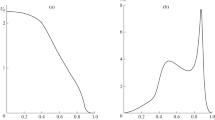Abstract
The laminar-turbulent transition zone is investigated for a broad class of jet flows. The problem is considered in terms of the inviscid model. The solution of the initial-boundary value problem for three-dimensional unsteady Euler equations is found by the Bubnov-Galerkin method using the generalized Rayleigh approach [1–4]. The occurrence, subsequent nonlinear evolution and interaction of two-dimensional wave disturbances are studied, together with their secondary instability with respect to three-dimensional disturbances.
Similar content being viewed by others
Literature cited
J. W. S. Rayleigh, The Theory of Sound, 2nd ed., Macmillan, London (1894, 1896); reprinted Dover, New York (1945).
G. I. Petrov, “Stability of vortex sheets,” Tr. TsAGI, No. 304, 24 (1937).
S. Ya. Gertsenshtein, “Application of the Rayleigh method to nonlinear and three-dimensional problems,” Dokl. Akad. Nauk SSSR,231, 1319 (1976).
S. Ya. Gertsenshtein, A. N. Sukhorukov, and V. Ya. Shkadov, “Nonlinear oscillations in a plane wake,” Izv. Akad. Nauk SSSR, Mekh. Zhidk. Gaza, No. 3, 10 (1977).
R. Betchov and W. O. Criminale (Jr), Problems of Hydrodynamic Stability [Russian translation], Mir, Moscow (1971) (possibly translation of: Stability of Parallel Flows, Academic Press, New York (1967)).
H. Sato and H. Saito, “Artificial control of the laminar-turbulent transition of a two-dimensional wake by external sound,” J. Fluid Mech.,84, 657 (1978).
A. S. Ginevskii, E. V. Vlasov, and A. V. Kolesnikov, Aeroacoustic Interactions [in Russian], Mashinostroenie, Moscow (1978).
Yu. S. Kouhanov, V. Koslow, V. Ya. Levchenko, and M. P. Ramasanov, “On nature of k-breakdown of a laminar boundary layer. New experimental data.” The Second IUTAM-SYMPOSIUM on Laminar-Turbulent Transition. Abstracts, Novosibirsk (1984), p. 13.
S. A. Orszag and A. T. Patera, “Secondary instability of wallbounded shear flows,” J. Fluid Mech.,128, 347 (1983).
T. Herbert, “Secondary instability of plane channel flow to subharmonic three-dimensional disturbances,” Phys. Fluids,26, 871 (1983).
V. G. Priimak and B. L. Rozhdestvenskii, “Numerical modeling of two-dimensional turbulence in a plane channel,” in: Abstracts of Proceedings of Fifth All-Union Conference on Theoretical and Applied Mechanics, Alma-Ata, 1981, Nauka, Alma-Ata (1981), pp. 295–296.
S. Ya. Gertsenshtein and A. N. Sukhorukov, “Nonlinear evolution of two-dimensional and three-dimensional waves in mixing layers,” Izv. Akad. Nauk SSSR, Mekh. Zhidk. Gaza, No. 1, 10 (1985).
Author information
Authors and Affiliations
Additional information
Translated from Izvestiya Akademii Nauk SSSR, Mekhanika Zhidkosti i Gaza, No. 5, pp. 8–19, September–October, 1985.
Rights and permissions
About this article
Cite this article
Gertsenshtein, S.Y., Olaru, I.I., Hudnitokii, A.Y. et al. Development of finite-amplitude two-dimensional and three-dimensional disturbances in jet flows. Fluid Dyn 20, 668–679 (1985). https://doi.org/10.1007/BF01050077
Received:
Issue Date:
DOI: https://doi.org/10.1007/BF01050077



